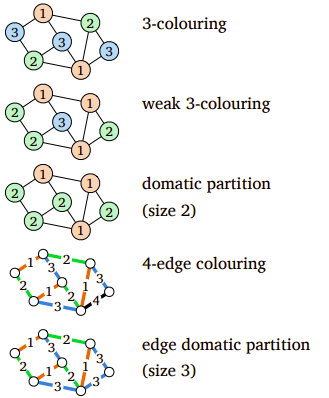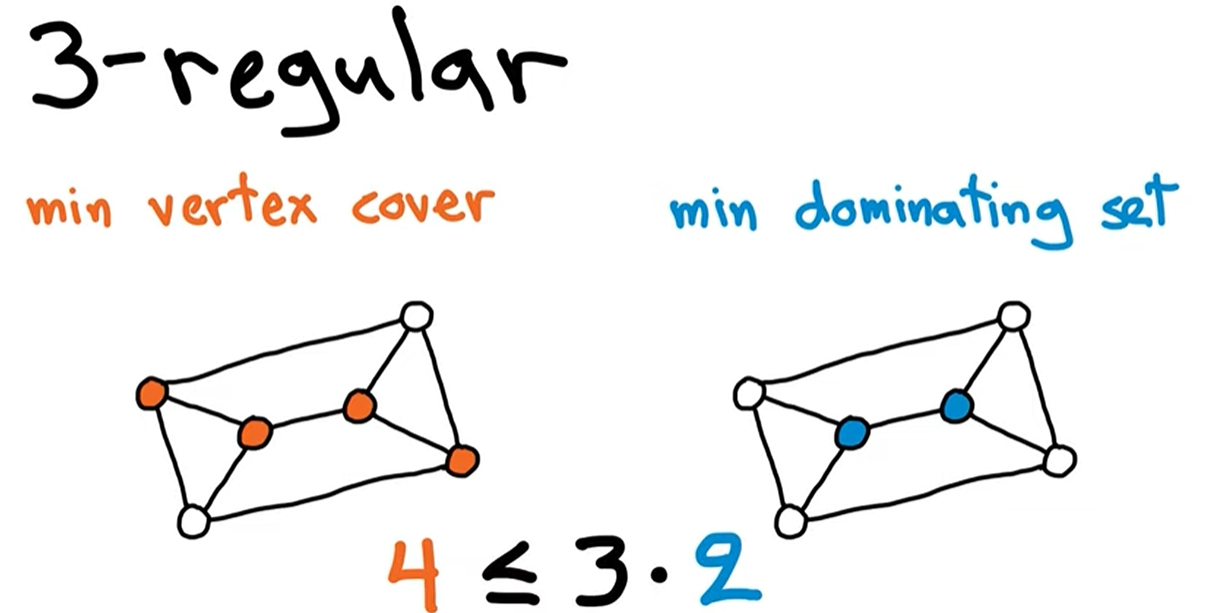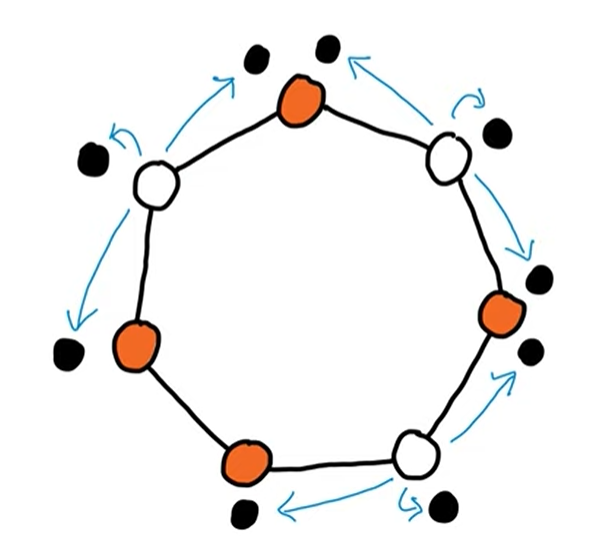Basic Terminologies such as
- Undirected and directed graphs
- Adjacency , Degree , k-regular
- Subgraphs , Induced subgraph (Vertex/Edge induced) , Spanning subgraph
- Walks, Cycles, Paths, Trail
- Connectivity, Distance, Diameter, Tree, Isomorphism
are assumed to be known already.
Packing and Covering
A subset of nodes is
- an independent set if each edge has at most one endpoint in . In other words, for all .
- a vertex cover if each edge has at least one endpoint in . In other words, for all .
- a dominating set if each node has at least one neighbor in . In other words, for all , where
A subset of edges is
- a matching if each node has at most one incident edge in . In other words, .
- an edge cover if each node has at least one incident edge in . In other words, .
- an edge dominating set if each edge has at least one neighbor in . In other words, for all .
Labelings and Partitions
We will often encounter functions of the form
There are two interpretations that are often helpful:
- Function assigns a label to each node .
- Function is a partition of . More specifically, where .
Similarly, we can have functions of the form
and interpret it as a labeling of edges or as a partition of .
We say that a function is
- a proper vertex coloring if is an independent set for each .
- a weak coloring if each non-isolated node has a neighbor with .
- a domatic partition if is a dominating set for each .
A function is
- a proper edge coloring if is a matching for each
- an edge domatic partition if is an edge dominating set for each .

Factors and Factorizations
Let be a graph, let be a set of edges, and let be the subgraph of induced by . We say that is a -factor of if and for each .
Equivalently, is a -factor if induces a spanning -regular subgraph of . A function is a -factorization of if is a -factor for each .
Following observations can be made from this
- A -factor is a maximum matching. A -factorization is an edge coloring.
- The subgraph induced by a -factor consists of disjoint cycles.
- A -factor is also known as perfect matching.
Approximations
Formally, the definition of a maximization problem consists of two parts: a set of feasible solutions and an objective function . In a maximization problem, the goal is to find a feasible solution that maximizes . A minimization problem is analogous.
Often it is infeasible or impossible to find an optimal solution, hence we resort to approximations. Given a maximization problem , we say that a solution is an -approximation if , and we have for all . Note that in this case. The same applies for a minimization problem as well, with the constant on the other side with reverted inequality.
Let’s prove a example theorem.
Claim:
In any -regular graph , a minimum vertex cover is always a -approximation of a minimum dominating set.

Proof:
First let us a show that a minimum vertex cover is a dominating set. Let be any vertex cover. It is fairly straightforward that since is a vertex cover, every edge has at least one endpoint in , which means any node which is not in has at least one of its neighbor in .
Now to show that the minimum vertex cover is always a -approximation of a minimum dominating set, consider a minimum vertex cover and a dominating set . We need to show that .
Since the graph is -regular, therefore . This is because for any vertex in , since it has a degree and by the definition of dominating set, the union of neighbors ( neighbors) and vertex itself from all the vertices in must contain all the vertices in the graph.
Consider , the set of nodes that are not in the minimum vertex cover .

Similar to the above argument, . Again to put in perspective, this says that the union of all neighbors and vertex itself for each vertex in equals . This is not really evident at first. Let’s prove this by contradiction. Suppose there was a vertex such that it is missed out while taking the union. Now and all the neighbors of are also not in . This means that and all the neighbors of both belong to the set . But this leads to a contradiction, since removing from this set still gives us a vertex cover which has a cardinality lesser than .
The result now follows up eventually. We know
Since , therefore
Previously, we had . Combining these two, we get
which is the required result.
One key point to note is that we didn’t really use the property that is a minimum vertex cover, rather we used the property that any minimum vertex cover is also a minimal vertex cover. Thus, this claim holds true even when we consider any minimal vertex cover.
What if we used any vertex cover instead of ? The statement doesn’t hold true now. The simplest counterexample would be considering the vertex cover that covers all the vertices. Choose and . Here , while , contradicting the claim.
Exercises
Will be added soon